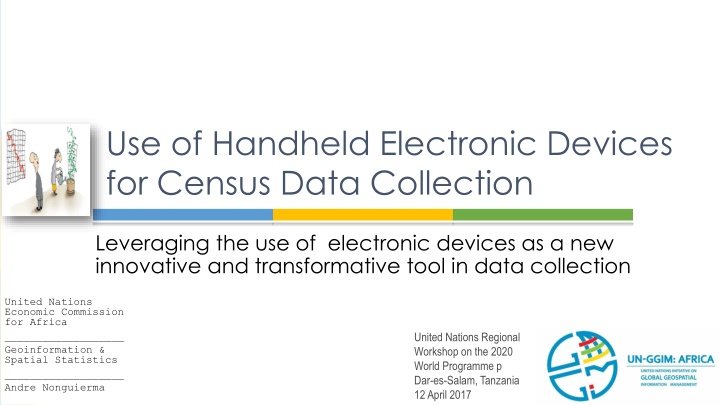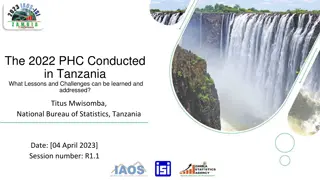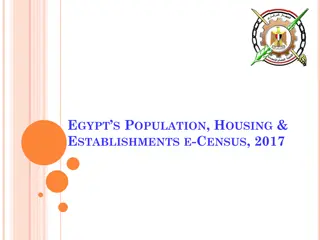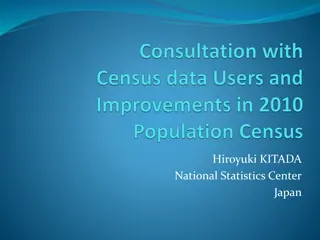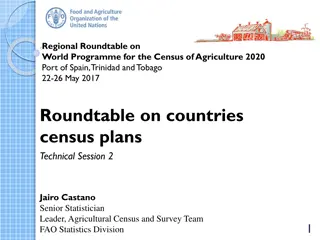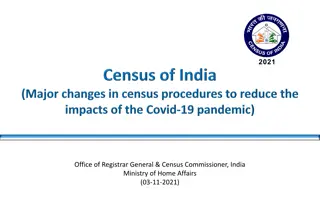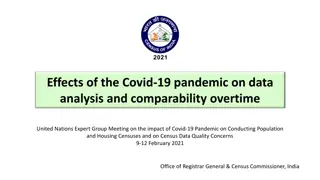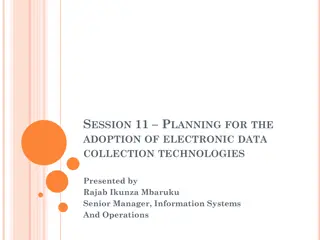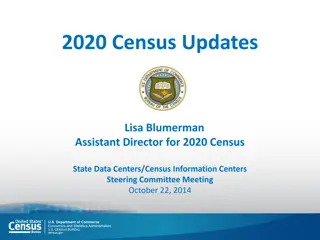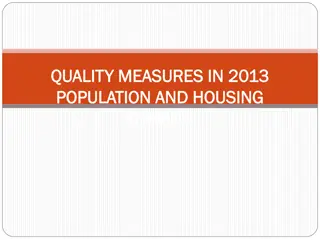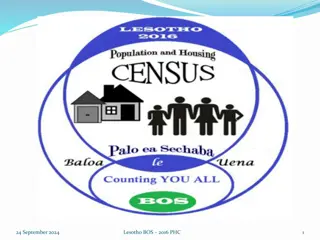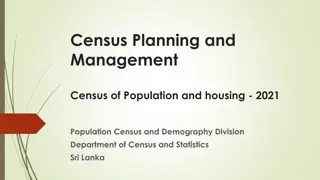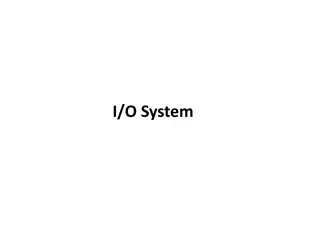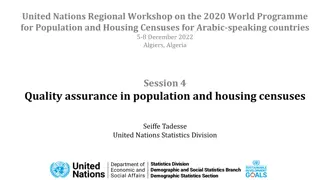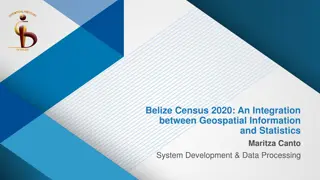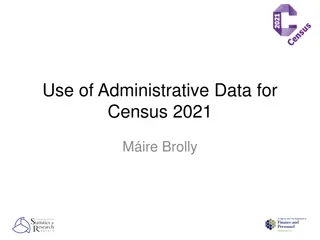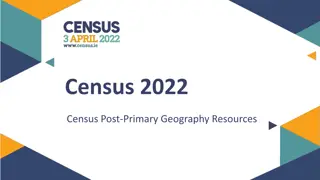Leveraging Handheld Electronic Devices for Census Data Collection
This article discusses the use of handheld electronic devices for census data collection, highlighting the advantages over traditional methods and the impact on data quality and efficiency. It emphasizes leveraging mobile devices as innovative tools in data collection for sustainable development.
Download Presentation

Please find below an Image/Link to download the presentation.
The content on the website is provided AS IS for your information and personal use only. It may not be sold, licensed, or shared on other websites without obtaining consent from the author.If you encounter any issues during the download, it is possible that the publisher has removed the file from their server.
You are allowed to download the files provided on this website for personal or commercial use, subject to the condition that they are used lawfully. All files are the property of their respective owners.
The content on the website is provided AS IS for your information and personal use only. It may not be sold, licensed, or shared on other websites without obtaining consent from the author.
E N D
Presentation Transcript
Use of Handheld Electronic Devices for Census Data Collection Leveraging the use of electronic devices as a new innovative and transformative tool in data collection United Nations Economic Commission for Africa ___________________ Geoinformation & Spatial Statistics ___________________ Andre Nonguierma United Nations Regional Workshop on the 2020 World Programme p Dar-es-Salam, Tanzania 12 April 2017
Background Within its framework and mandate to promote Africa s sustainable development, ECA is committed to assist member States to build their statistical capacities as well as to work with its development partners to strengthen the National Statistical Systems (NSS) through enhancing the National Strategies for the Development of Statistics (NSDS). ECA is leveraging the use of electronic devices as a new innovative and transformative tool in data collection aimed at assisting the member states in producing and disseminating quality data for their environment and socio-economic development through a Development Account project. This initiative is motivated by the remarkable advantages of mobile devices over traditional survey methods in data collection expressed in terms of both efficiency (in sense of cost and time) and effectiveness (in sense of data quality) which in turn represent the main objectives of mobile devices systems such as those using the Computer Assisted Personal Interviewing (CAPI) approach in data collection, data processing and data dissemination.
Mobile Devices Hardware and Software for Data Collection Mobile device is a small handheld device having computing power and a display screen with keyboard. It also has an operating system (OS), and can run various types of application software, known as apps. Most mobile devices can also be equipped with Wi-Fi, Bluetooth, and GPS capabilities that can allow connections to the Internet and other Bluetooth capable devices. A camera or media player feature for video or music files can also be found on such devices. There are many types of mobile devices, the commonest among them being, mobile phones, smartphones, PDAs, pagers and Personal Navigation Devices. Mobile phones are grouped in to two classes: feature and smart phones. Feature phones are limited in capabilities in contrast to smartphones. They typically provide voice calling and text messaging functionality, in addition to basic multimedia and internet capabilities, and other services offered by the service provider. Smartphones on the other hand have advanced computing capability and connectivity than feature phones. They include the features of a feature phone plus the features of a touchscreen computer, including web browsing, Wi-Fi, 3rd-party apps, motion sensor. Smartphones also include feature of personal digital assistant, media players, digital camera, and GPS navigation unit. Types of mobile devices: Tablet PCs Ultra-mobile PCs (UMPCs) Mobile internet devices (MIDS) Smartphones PDAs Mobile Operating System A mobile operating system, also called a mobile OS, is an operating system that is specifically designed to run on mobile devices such as mobile phones, smartphones, PDAs, tablet computers and other handheld devices. The mobile operating system is the software platform on top of which other programs, called application programs, can run on mobile devices.
Mobile Devices Hardware and Software for Data Collection Main features for a desirable mobile device Feature Affordability Price of the device License/subscription cost Maintenance fees Annual/monthly renewal fees User interfaces, colour, resolution Interface Battery life and management OS updates Length of battery life One of the concerns of smartphones is battery How OS is regularly updated with big releases and features How users can customize their experiences including shortcuts, color schemes, keyboards... Storage capacity The ecosystem of peripherals Customizability Storage/Memory Peripheral support
Data Collection System Mobile applications or mobile apps are applications developed for small handheld devices, such as mobile phones, smartphones, PDAs and so on. Mobile apps can come preloaded on the handheld device as well as can be downloaded by users from app stores or the Internet. You can find mobile apps on both feature phones and smartphones. The most popular smartphone platforms that support mobile apps are IOS, Android, Symbian, Windows Mobile, Java ME and Palm. Category of mobile data collection system Open Data Kit (ODK) is a free and open-source set of tools which manage mobile data collection solutions. CSEntry collects data for surveys created by the free Census and Survey Processing System (CSPro) suite of data processing tools. CSEntry is used for computer assisted personal interviewing (CAPI) on Android phones and tablets. EpiCollect is a free and open source project developed by Department of Infectious Disease Epidemiology of the Imperial College London. It is a mobile app for the generation of forms (questionnaires) and freely hosted project websites for data collection. iFormBuilder is a cloud based mobile data collection platform to collect data on mobile devices. It builds forms, and collect data with online and off-line. iFormBuilder app is available for android and iOS. SurveyMonkey is one of the major online survey tool which has also capability on mobile devices. SurveyMonkey provides features to create and manage surveys on mobile interfaces. SurveyToGo is a Mobile Data Collection Software that enables you to create, conduct & manage electronic mobile surveys. It provides both online and offline data collection support. SurveyToGo multiple language support and images, videos and voice can be recorded along with data collection. FrontlineSMS has a large user base of organizations requiring SMS only forms. It can be simple to set up in the best case, but many users report a troublesome initial experience. ViewWorld is a simple, quick, commercial tool with cloud hosting. The Android app is built on xForms / ODK, while the iOS version is proprietary.
Data Collection System Key criteria for selecting a mobile device Affordability License/subscription cost Maintenance fees Annual/monthly renewal fees Android iOS Local language support Support data collection without internet and mobile network Can try geo location Availability of Audiovisual recording Server / sync module export formats Database auto-generated? (list formats) Export data to other statistical software Integration with PAPI, CAPI, web Multiple OS support Multiple language support Offline data collection support GPS location capturing Camera, video & voice recording Interoperability and connectivity Multimodal data collection support Security Data encryption Biometrics Availability of survey designer functionality Easy to user survey designer
Data Collection System (Contd) Key criteria for selecting a mobile device Can sync via SMS Interrupted sync resumes? Runs without creating/using a Sync module Type of sync (cloud, server type, etc.) Data storage local or in cloud? Bi-directional sync of data Forms can be downloaded/updated in the field Sync tracking manages re-synchronization Validation mechanisms Automatically synchronize questionnaires Robust error and consistency checking Use reference files for panel surveys Implement complex logic Form features (support for features like mandatory questions, skip patterns, and multiple languages) Availability of reference materials Programming language support Question branching and looping Subforms Dropdown lists Skip patterns Mandatory questions Data range & type enforcement Help (tool tips) Pre-selected responses Automated calculations (for data validation) Default values Field length enforcement Easily adapted screen layout (fonts, icons, colors)
Data Collection System (Contd) Import/export facity to RDBMS, and common formats like CSV, ASCII, Excel Interoperability and Connectivity (export formats and database details) Hardware requirements and capabilities supported (device, desktop, and server operating systems; device features, like GPS, photos, etc.) Key criteria for selecting a mobile device Device OSes supported Desktop OS required for tool Server/Database Platform GPS Pictures Video Audio Bar Codes Open Source? Module has access/security/rights management User friendly (forms can be modified easily) Forms can be created without coding knowledge Alert messages Can browse completed records in a structured way on the device Can browse completed records in a structured way from computer Data can be entered from a computer System features and platform characteristics (open or closed source; user friendliness; methods for reviewing data)
Data Collection System (Contd) Key criteria for selectin g a mobile device Visualization and analysis features, with a visualization component (import/export formats; graphs and charts; reporting features, etc.) Is the visualization tool standalone or integrated Data formats that can be imported Are basic graph types supported? Mapping built in? Auto-generated reporting? ... with custom designed dashboards? Flexible queries? One way-table and graphs Cross tabulation Apply filter or strata: Formats that graphs/tables/maps can be exported to
Transmission of Collected Data National Data Center (NDC) needs a file collection mechanism to collect from and to send data to the primary sampling unit (PSU) on the field. Regular transmission of data from the field to Central Data Center (CDC) is vital for the management of data collected with mobile devices and for early detection and resolution of potential problems. In other hand, case assignment, questionnaire and application updates are very important issues that can improve logistical organization and data quality. Fully or Partial web model Flash drives based model Voice Short message service (SMS) or Unstructured Supplementary Service Data (USSD)
MobileGIS Devices : Features Mobile GIS is the combination of GIS, GPS and mobile computing devices. Mobile GIS allows for visualization of information in a digital map interface, while interacting directly with the real world around. Mobile GIS increases the accuracy and efficiency of data collection. Collecting spatial data within a GIS environment in the field improves the quality and accuracy of data. Software designed to run on mobile computers usually have functionalities for GIS layering, map navigation, querying and hyper linkages. Standard data formats permits the display, query, edit, capture and support for optional GPS receivers functionalities and are capable to be used in desktop computers. Main characteristics Mobile GIS devices must be environmental friendly, light-weighted, mission specific, easy to configure. Data Projections and Datum Data Display and Data Query Map Navigation Map Querying Map Display Editing and Data Capturing Form Creation Wizard Supporting GPS Receivers
MobileGIS Devices : Features Data Capture Options Points mode digitalization or Stream mode digitizing. All data can be recorded as a "track log" that is stored as a point shapefile, stored as a point location (waypoint), or used to capture polygons and polylines in a shapefile. Supporting Desktops Software can be customized to support desktops and handheld devices, questionnaire forms can be designed on desktops and transferred into the mobile GIS environment. Map files can be created as well as converted on desktops before loading data into the mobile GIS environment. Internationals and Native Languages Several international and native languages are developed as part of these devices making it possible for massive usage of these devices. Customization Applications can be customized to collect data for specific areas such as; crime, hydrology, defends, forestry, mining etc. GIS Cloud Mobile Data Collection Application Mobile devices enable the collection of data and conducting of field surveys faster and easier.
The Right Technology Services Data collection with mobile devices is based on appropriate IT infrastructures, equipments and software. The right technical equipment Mobile devices for statistical data collection can range from simple phone that can only be used for phone-calls, SMS s and USSD s, to specialized devices such as smart phone, tablets and notebooks. The right software The software must cover at least data collection, data control and verification, data transfer, data validation and data quality. Software for data collection, control, validation and transfer is mainly required for smart phones, tablets and notebooks. It might not required for simple phones used for sending data through voice, SMS or USSD. But software for data aggregation and data quality is required whatever the mobile device used for data collection. The right data management system
